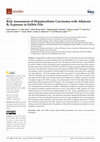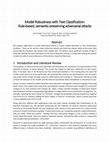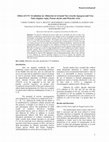Papers by Dr. Farhat Jubeen
Arabian Journal of Chemistry
UNIVERSITY OF AGRICULTURE FAISALABAD, PAKISTAN, 2012
All Praise for the ALMIGHTY ALLAH, the omnipotent, the omnipresent, the most merciful and the mos... more All Praise for the ALMIGHTY ALLAH, the omnipotent, the omnipresent, the most merciful and the most compassionate who blessed me with sound health, realistic thinking and opportunity for higher studies and his Holy Prophet, MUHAMMAD (Peace be upon him) the most perfect and exhaled among ever born on the earth.
Arabian Journal of Chemistry

Toxins
Contamination of edible oils with aflatoxins (AFs) is a universal issue due to the detrimental ef... more Contamination of edible oils with aflatoxins (AFs) is a universal issue due to the detrimental effects of aflatoxins on human health and the fact that edible oils are a major source of fungal growth, particularly storage fungi (Aspergillus sp.). The objective of this study was to assess aflatoxin B1 (AFB1) in edible oil used in fried food in order to determine the risk of cancer from AFB1 exposure through cooked food using the FAO/WHO’s and EFSA’s margin of exposure (MOE) quantitative liver cancer risk approaches. Using Mycosep 226 columns and HPLC-FLD, 100 samples of cooking oils (soybean, canola, and sunflower oil) from different food points were analyzed for contamination with aflatoxins. Of all the samples tested, 89% were positive for total aflatoxins and AFB1, with 65% indicating AF concentrations beyond permitted levels. Canola oil was found to contain higher levels of AFB1 and AFs than soybean and sunflower oil. Almost 71 percent of canola oil samples (range of 54.4–281.1 µg...
International Journal of Agriculture and Biology, 2012

Journal of Environmental Chemical Engineering, 2021
Abstract The loading of novel bi-and tri-metallic bifunctional catalysts such as Pt–Ru, Pt–Zr, an... more Abstract The loading of novel bi-and tri-metallic bifunctional catalysts such as Pt–Ru, Pt–Zr, and Pt–Ru–Zr over original zeolites (H-MOR and H-ZSM-5) and new cations modified zeolites (Sr-MOR, Ba-MOR, Sr-ZSM-5, and Ba-ZSM-5) by supercritical CO2 method are investigated for n-hexane isomerization. A fixed bed micro-reactor unit was used for catalytical hydro-isomerization of n-hexane at different temperature ranges (250–325 °C), H2/HC ratios of 3, 6, and 9 mol and pressure of 5 bar. The chemical and physical properties of prepared zeolite nanoparticles were characterized by Fourier transform infrared spectroscopy (FT-IR), X-ray diffraction (XRD), Brunauer–Emmett–Teller (BET), and thermogravimetric analysis (TGA). It is reported that the metal loaded in scCO2, results in more uniform and tiny metal nanoparticle (1.37 nm) dispersion with high stability and revealed that high loading pressure in scCO2 (280–300 bar) results in higher catalytic activity and surface area. H-MOR and H-ZSM-5 possess the maximum BET surface area of 539.21 and 403 m2/g and pore size of 90.73 and 105.06 A respectively. The finding also revealed the maximum n-hexane conversion and selectively of about 99.10% and 32.23% for Pt–Ru/H-ZSM-5%, 93.55%, and 99.72% for Pt-Zr/H-ZSM-5, and 97% and 29.74% for Pt–Ru–Zr/H-MOR catalysts respectively at H2/HC ratio of 9 and 250–325 °C. Moreover, Pt–Ru/H-ZSM-5, Pt–Zr/Ba-ZSM-5, and Pt–Ru–Zr/Ba-ZSM-5 showed the maximum yield of 11.5% and 17.7%, 40.58% and 33.19%, and 11.5% and 9.1% of 2-methyl-pentane (2-MP) and 3-methyl-pentane (3-MP) respectively at H2/HC ratio 9 and 250–325 °C. Based on results, it is concluded that Pt–Zr catalyst over ZSM-5 showed better catalytical activity among all for n-hexane isomerization, while Pt–Ru and Pt–Ru–Zr demonstrated better hydrocracking reactions.

Journal of Cancer Research and Practice, 2019
Background: In addition to exhibiting antitumor potential, antitumor drugs exhibit toxicity due t... more Background: In addition to exhibiting antitumor potential, antitumor drugs exhibit toxicity due to a poor pharmacokinetic profile. An enormous amount of research has been carried out and is still ongoing to obtain more targeted, potent, and safe drugs to treat cancer, and pharmacokinetic evaluations of anticancer drugs are needed. Objectives: The present review examined different delivery systems and methodologies designed in recent years to investigate the pharmacokinetics of the anticancer drug, 5-fluorouracil (5-FU). These methodologies highlight how the issues of bioavailability, absorption, half-life, targeted neoplastic cell potential, and high therapeutic index of 5-FU are resolved. Results: A number of naturally occurring macromolecules such as modified starch, porphyran, peptides, and folic acids have been found to be successful in vitro to improve the permeability and retention effect of 5-FU against solid tumors. A promising approach for targeted 5-FU delivery to oncoproteins has resulted in a number of potentially sound anticancer nanocomposites. Chitosan nanoparticles loaded with 5-FU have been shown to exhibit cytotoxicity equivalent to 5-FU injections against gastric carcinoma. At the level of inter- and intra-molecular interactions, the co-crystal approach has been found to be successful against colorectal cancer proteins. Because of the 5-FU ligand-like nature and its metal-binding potential, researchers have shifted attention toward the synergistic co-administration of gold complexes with this drug. Conclusions: This study highlighted the techniques used to improve the pharmacokinetics of 5-FU and that "nanocarriers" are a promising approach in this field. The conclusion is supported by solid evidence.

Biocatalysis and Agricultural Biotechnology, 2020
We propose algorithms to create adversarial attacks to assess model robustness in text classifica... more We propose algorithms to create adversarial attacks to assess model robustness in text classification problems. They can be used to create white box attacks and black box attacks while at the same time preserving the semantics and syntax of the original text. The attacks cause significant number of flips in white-box setting and same rule based can be used in black-box setting. In a black-box setting, the attacks created are able to reverse decisions of transformer based architectures. Along with this, different NLP applications have also been tested, including Text Classification [2, 4], Machine Translation [5], and Question Answering. [6] The collection of research related to adversarial learning can be broadly divided into two categories, with respect to how adversaries are created and the amount of model information available. If adversarial inputs are created by using the model information, they are called "white box attacks". Perhaps the more interesting category is one in which nothing is known about the model. These are called as "black box attacks". We will also refer to them as "supervised and unsupervised perturbations" of the data. Research in adversarial attacks for deep learning models started with the introduction of a brute force attack to change the model prediction [7]. Since then, research in this field has exploded and many different types of attacks have been explored. Adversaries are created using different definitions of distance between the original input and perturbed input, including L0, L1 and L2 norms [8]. While there are many types of perturbations including random ones, the most common white-box attacks are gradient-based [1] that use projected gradient information in the model to determine the "best" perturbation and create adversaries.
Crystal Growth & Design, 2020
This document is the author's post-print version, incorporating any revisions agreed during the p... more This document is the author's post-print version, incorporating any revisions agreed during the peer-review process. Some differences between the published version and this version may remain and you are advised to consult the published version if you wish to cite from it.

Journal of Materials Research and Technology, 2019
Abstract In the present study, sorption efficacy of chitosan (β-(1→4)-linked d -glucosamine and N... more Abstract In the present study, sorption efficacy of chitosan (β-(1→4)-linked d -glucosamine and N-acetyl- d -glucosamine) composite for synthetic direct Rose FRN dye removal from aqueous media was investigated. Chitosan and clay were subjected to chemical modifications to prepare chitosan/clay composite. Batch sorption affecting parameters like pH, composite dose, volume, initial dye concentration, time and temperature were optimized. Maximum sorption capacity (17.18 mg/g) was found within first 40 min of contact. Point of zero charge was found to be 7.0. Linearized and non-linearized regression forms of pseudo 1st and 2nd order kinetic models were used to predict the nature of rate limiting steps involved in the sorption process. Sorption equilibrium data was revealed by applying linear and non-linear equilibrium Langmuir, Freundlich and Redlich–Peterson isotherm models. Calculated values of thermodynamic factors showed that sorption process is exothermic, spontaneous and feasible. Desorption studies were performed for the regeneration of chitosan/clay composite by using different eluting agents. The synthesized composite were characterized by X-ray diffraction (XRD), surface analysis (Brunauer, Emmett and Teller: BET), scanning electron microscopy (SEM), Fourier transforms infrared spectroscopy (FTIR) and thermogravimetric analysis (TGA). The developed method was also applied on the real textile effluent for the efficient removal of dyes.

Synthetic Communications, 2018
Among all heterocyclic compounds, pyrimidine is of prime interest, exhibit broad spectrum of biol... more Among all heterocyclic compounds, pyrimidine is of prime interest, exhibit broad spectrum of biological activities, because of its occurrence in deoxyribonucleic acid bases. The bioactive moiety pyrimidine has a voluminous therapeutic profile as it is a vital component of a series of natural composites and chemotherapeutic drugs. Since from last 50-60 years, this motif has been used commendably against bacterial, tuberculosis viral, malarial, fungal, and cancerous contagions. Recently, numerous pyrimidine derivatives were synthesized and discussed here, fused with other heterocyclic moieties, pyrazole, coumarine, triazole, alkenyloxindole, hydrazine and others, were also investigated for their bioactivities. Amid all recently reported compounds, several exhibit potentials against breast cancer cell lines. Intensive research has been performed and is going ahead with distinctive emphasis on antineoplastic potential of pyrimidine. These widespread medicinal attributes impulse scientists to synthesize more and more biologically active pyrimidine composites by following simple and eco-friendly routes.

Journal of hazardous materials, Jan 10, 2017
The large amount of synthetic dyes in effluents is a serious concern to be addressed. The chemica... more The large amount of synthetic dyes in effluents is a serious concern to be addressed. The chemical reduction is one of the potential way to resolve this problem. In this study, linear and crosslinked polyurethanes i.e. LPUR & CLPUR were synthesized from toluene diisocyanate (TDI), polyethylene glycol (PEG;1000g/mole) and tetraethylenepentamine (TEPA). The structure and morphology of synthesized materials were examined by FTIR, SEM and BET. The CLPUR was found stable in aqueous system with 0.80g/cm(3) density and 16.4998m(2)g(-1) surface area. These materials were applied for the reduction of methylene blue in presence of NaBH4. Both, polymers catalyzed the process and showed 100% reduction in 16 and 28mins., respectively, while, the reduction rate was significantly low in absence of these materials, even after 120mins. Furthermore, negligible adsorption was observed with only 7% removal of dye. The best reduction rates were observed at low concentration of dye, increasing concentrat...
All Praise for the ALMIGHTY ALLAH, the omnipotent, the omnipresent, the most merciful and the mos... more All Praise for the ALMIGHTY ALLAH, the omnipotent, the omnipresent, the most merciful and the most compassionate who blessed me with sound health, realistic thinking and opportunity for higher studies and his Holy Prophet, MUHAMMAD (Peace be upon him) the most perfect and exhaled among ever born on the earth.

The objective following the present study was to investigate the effect of ultra violet irradiati... more The objective following the present study was to investigate the effect of ultra violet irradiation on aflatoxins in ground and tree nuts. Samples of nuts were randomly selected from the retail market of Faisalabad. The moisture contents of the nuts were artificially increased to 10±3% and 16±3% to facilitate the mold growth. The samples were stored at a room temperature of 25-30 °C for 12 weeks. The stored nut samples were checked after a storage period of 12 weeks, the fungi were found growing in all nuts along with considerable aflatoxins production. Aflatoxins and mold contaminated samples were exposed to UVC radiations of 265nm for 15, 30 and 45 minutes. The fungicidal activity of UVC radiation was more pronounced in nuts adjusted at high moisture level. The order of sensitivity of nuts for fungal disinfection by UVC irradiation was walnut> almond= pistachio> peanuts. There was a proportional decrease in aflatoxins level with increase in exposure time. Complete elimination of aflatoxin G 2 was achieved in all nut samples after 15min. exposure, while aflatoxin G 1 showed 100% degradation only in almond and pistachio. After 45 min. exposure to UVC, aflatoxin B 1 showed maximum reduction of 96.5% in almond and pistachio. The degradation of total aflatoxins as well as that of aflatoxin B 1 by UVC irradiation was found to follow first order kinetics.
Asian Journal of Chemistry, 2013
Archiv der Pharmazie, 2013
A series of novel di-a-aminophosphonate derivatives were synthesized by a one-pot method in the p... more A series of novel di-a-aminophosphonate derivatives were synthesized by a one-pot method in the presence of PEG-H 2 O under ultrasonic irradiation and were characterized by IR, 1 H NMR, 13 C NMR, mass spectrometry, and elemental analysis. The newly synthesized compounds were evaluated for their cytotoxic activities against the human lung cancer cell line H1299 and the human breast cancer cell line MCF7 in vitro by the MTT method. All compounds showed moderate cytotoxic activity on both cell lines, and compounds 4b and 4c showed marked activity.
Society of Photo-Optical Instrumentation Engineers (SPIE) Conference Series, Jul 1, 2021
AAPS PharmSciTech, 2005
This article is an open access article distributed under the terms and conditions of the Creative... more This article is an open access article distributed under the terms and conditions of the Creative Commons Attribution (CC BY










Uploads
Papers by Dr. Farhat Jubeen